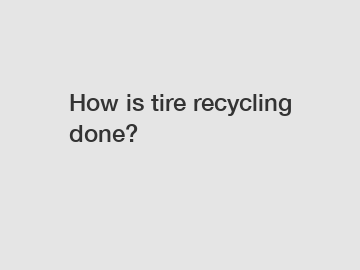How is tire recycling done?
Tire Recycling Process: Transforming Waste into Resources.
Tires are an essential part of our vehicles, providing traction and ensuring a smooth ride. However, when tires reach the end of their lifespan, they become a significant environmental concern due to their non-biodegradable nature and potential for causing pollution. Recycling tires is crucial to reduce the impact on the environment and create valuable resources. If you have ever wondered how tire recycling is done, read on to learn more about this fascinating process.
Collection and Sorting of Tires.

The first step in tire recycling involves collecting used tires from various sources, including tire shops, auto repair shops, and waste management facilities. These tires are then sorted based on their condition and size. Tires that are in good condition can be retreaded or reused, while damaged or worn-out tires are sent for recycling.
Shredding and Cutting.
Once the tires are sorted, they are sent to a shredding machine where they are cut into small pieces. This process helps to increase the surface area of the tire, making it easier to extract the valuable materials contained within. The shredded tire pieces are then further processed to remove any steel or nylon fibers that may be present.
Crumb Rubber Production.
After the shredding and cutting process, the tire pieces are further processed to produce crumb rubber. This is done by grinding the shredded tire pieces into smaller particles using specialized equipment. The resulting crumb rubber can be used in a variety of applications, including playground surfaces, athletic tracks, and molded products.
Pyrolysis.
Pyrolysis is another method used in tire recycling, which involves heating the tires in the absence of oxygen to break them down into their basic components, such as oil, gas, and carbon black. The oil and gas produced during pyrolysis can be used as fuels, while the carbon black can be used as a filler in the manufacturing of rubber products.
Reclaimed Rubber Production.
One of the most common methods of tire recycling is producing reclaimed rubber. This process involves grinding the tire pieces and removing any impurities to create a high-quality rubber material that can be used in the production of new tires, rubber mats, and other rubber products. Reclaimed rubber is a cost-effective and sustainable alternative to virgin rubber, helping to reduce the demand for natural rubber resources.
Benefits of Tire Recycling.
Tire recycling offers numerous environmental and economic benefits. By recycling tires, we can reduce the amount of waste sent to landfills, reduce the demand for raw materials, and conserve energy. Additionally, recycling tires helps to prevent pollution and reduce greenhouse gas emissions associated with tire production.
In conclusion, tire recycling is a crucial process that helps to reduce waste, conserve resources, and protect the environment. By implementing innovative recycling technologies and practices, we can transform used tires into valuable resources that benefit society. If you have old tires that need to be recycled, consider reaching out to a reputable tire recycling facility in your area to ensure proper disposal and recycling of your tires.
Contact us to learn more about tire recycling and how you can contribute to a more sustainable future.
The company is the world’s best rubber shredder, tire recycling machinery for sale, rubber shredder machine supplier. We are your one-stop shop for all needs. Our staff are highly-specialized and will help you find the product you need.


